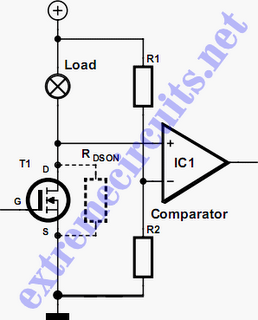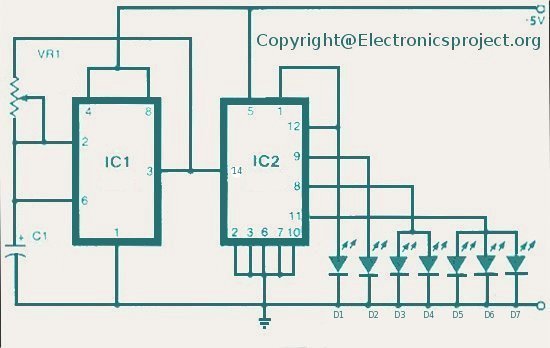
MOSFET short-circuit protection Schematic Diagram

In applications where a MOSFET is used to switch a load, it is relatively straightforward to incorporate short-circuit or overload protection. This can be achieved by utilizing the internal resistance RDS(ON), which generates a voltage drop proportional to the current flowing through the MOSFET. The voltage across this internal resistance can be monitored using a simple comparator or a transistor that activates at approximately 0.5V. This approach eliminates the need for a sense resistor (shunt), which typically introduces an undesirable additional voltage drop. The comparator can be interfaced with a microcontroller, allowing the software to implement appropriate countermeasures in the event of an overload, such as PWM regulation, alarms, or emergency stops. Additionally, it is possible to connect the comparator output directly to the gate of the MOSFET for immediate cutoff of the transistor in the event of a short circuit.
To implement this circuit, a MOSFET is selected based on the specific load requirements, ensuring that its RDS(ON) is suitable for the expected current levels. The voltage drop across the MOSFET can be calculated using Ohm's law (V = I * RDS(ON)), where I is the load current. A comparator IC, such as the LM393, can be employed to monitor the voltage drop across the MOSFET. The non-inverting input of the comparator is connected to the drain-source voltage, while the inverting input is set to a reference voltage corresponding to the 0.5V threshold.
When the current exceeds the threshold, the output of the comparator switches from low to high, which can be used to trigger a microcontroller's interrupt or directly drive the gate of the MOSFET. If the comparator output is connected to the microcontroller, the software can execute predefined routines to mitigate overload conditions, such as reducing the PWM duty cycle to lower the load current or activating an alarm system.
In cases of a direct connection from the comparator output to the MOSFET gate, the comparator must be configured to ensure that it can provide sufficient gate drive voltage to turn off the MOSFET rapidly. This can be accomplished using a pull-down resistor on the gate to ensure it turns off completely when the comparator output is low.
Overall, this circuit design provides an efficient method for implementing overload and short-circuit protection in MOSFET switching applications, enhancing the reliability and safety of electronic systems.If you have an application in which a MOSFET is already used to switch a load, it is relatively easy to add short-circuit or overload protection. Here we make use of the internal resistance RDS(ON), which produces a voltage drop that depends on the amount of current flowing through the MOSFET.
The voltage across the internal resistance can be sens ed using simple comparator or even a transistor, which switches on at a voltage of around 0. 5V. You can thus avoid the use of a sense resistor (shunt), which usually produces an undesirable extra voltage drop. The comparator can be monitored by a microcontroller. In case of an overload, the software can initiate suitable countermeasures (PWM regulation, alarm, emergency stop etc.
). It is also conceivable to connect the comparator output directly to the gate of the MOSFET, in order to immediately cut off the transistor in case of a short circuit. 🔗 External reference
To implement this circuit, a MOSFET is selected based on the specific load requirements, ensuring that its RDS(ON) is suitable for the expected current levels. The voltage drop across the MOSFET can be calculated using Ohm's law (V = I * RDS(ON)), where I is the load current. A comparator IC, such as the LM393, can be employed to monitor the voltage drop across the MOSFET. The non-inverting input of the comparator is connected to the drain-source voltage, while the inverting input is set to a reference voltage corresponding to the 0.5V threshold.
When the current exceeds the threshold, the output of the comparator switches from low to high, which can be used to trigger a microcontroller's interrupt or directly drive the gate of the MOSFET. If the comparator output is connected to the microcontroller, the software can execute predefined routines to mitigate overload conditions, such as reducing the PWM duty cycle to lower the load current or activating an alarm system.
In cases of a direct connection from the comparator output to the MOSFET gate, the comparator must be configured to ensure that it can provide sufficient gate drive voltage to turn off the MOSFET rapidly. This can be accomplished using a pull-down resistor on the gate to ensure it turns off completely when the comparator output is low.
Overall, this circuit design provides an efficient method for implementing overload and short-circuit protection in MOSFET switching applications, enhancing the reliability and safety of electronic systems.If you have an application in which a MOSFET is already used to switch a load, it is relatively easy to add short-circuit or overload protection. Here we make use of the internal resistance RDS(ON), which produces a voltage drop that depends on the amount of current flowing through the MOSFET.
The voltage across the internal resistance can be sens ed using simple comparator or even a transistor, which switches on at a voltage of around 0. 5V. You can thus avoid the use of a sense resistor (shunt), which usually produces an undesirable extra voltage drop. The comparator can be monitored by a microcontroller. In case of an overload, the software can initiate suitable countermeasures (PWM regulation, alarm, emergency stop etc.
). It is also conceivable to connect the comparator output directly to the gate of the MOSFET, in order to immediately cut off the transistor in case of a short circuit. 🔗 External reference





